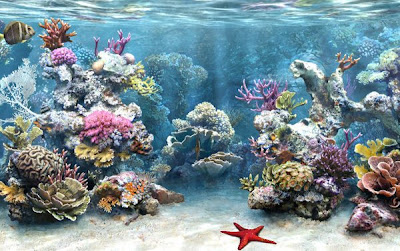 There are over 3,500 marine species living in the reefs and seas of Indonesia. In comparison to the Great Barrier Reef (1,500 species) and Red Sea (600 species), 25 % of all reefs in the world are in Indonesia.
There are over 3,500 marine species living in the reefs and seas of Indonesia. In comparison to the Great Barrier Reef (1,500 species) and Red Sea (600 species), 25 % of all reefs in the world are in Indonesia.The drop-offs, plateaus and slopes of the Gili's reflect a good cross-section of what Indonesia has to offer. Dive in and be fascinated by turtles, White-tip Reef Sharks, Cuttlefish, Moray Eels, Angel Fish, Ghost Pipefish and more.
Around the three Gili Island in the north-west of Lombok (Gili Air, Gili Meno, Gili Trawangan), are more then 15 different dive spots and there are new reefs being explored all the time.
Shark Point & Volkers' Golf Course
 Shark Point, to the east of Gili Trawangan, is a popular dive spot in the mornings. This dive site consists of different levels (24m, 20m, 18m). It starts with a slope of hard and soft corals, the "native territory" of Green and Hawksbill Turtles.
Shark Point, to the east of Gili Trawangan, is a popular dive spot in the mornings. This dive site consists of different levels (24m, 20m, 18m). It starts with a slope of hard and soft corals, the "native territory" of Green and Hawksbill Turtles.The different levels are sandy areas with small coral locks - the variety of underwater life is large, starting with schools of Trevally Napoleon Fish to White-tip Reef Sharks and Rays in the sandy areas, ending up with Ribbon Eels, Leaf Fish and even Mantas.
Volkers' Golf Course is about 500 m east of Shark Point and starts at a depth of about 20m. It looks green like a golf course and is the best site to see Sharks, Schools of Mackerel and Doctor Fish. Because of its depth and the sometimes very strong currents, it is a dive for advanced divers.
Meno Wall
Meno wall, off the west coast of Gili Meno, goes down to depths of 18m. It offers a lot of small coral fish like Lionfish, Soldier Fish, Gobies, crabs, as well as Wart Slugs and Nudibranches coming out of hiding. It is also called "Turtle Heaven" because of the many resident Hawksbill and Green Turtles.
Air Wall
 Air Wall, to the west of Gili Air, is a very beautiful wall that, due to the soft coral cover, shines yellow-orange depending on the position of the sun. The highlight of this wall is a coral block at 22m in which Leaf Fish (Scorpion Fish) make their "home", surrounded by shrimps, Pipe Fish, White-banded Cleaner Shrimps and thousands of Glass Fish. Look into the deeper parts for White-tip Reef Sharks.
Air Wall, to the west of Gili Air, is a very beautiful wall that, due to the soft coral cover, shines yellow-orange depending on the position of the sun. The highlight of this wall is a coral block at 22m in which Leaf Fish (Scorpion Fish) make their "home", surrounded by shrimps, Pipe Fish, White-banded Cleaner Shrimps and thousands of Glass Fish. Look into the deeper parts for White-tip Reef Sharks.Coral Fan Garden & Basket Coral Garden
Also popular for morning dives are the two dive spots in the north of Gili Trawangan: Coral Fun Garden and Basket Coral Garden. In the first few metres you have the feeling of being in an aquarium - schools of colored Fairy Basslets, Fusiliers, Banner Fish live here. Deeper, around the big coral and stone blocks, Groupers, Batfish, Trumpet Fish, hiding Octopus and Bearded Scorpion Fish. Look out to the blue: sometimes Eagle Rays, Mantas or Reef Sharks can be seen.
Manta Point
In the rainy season, when the water is rich with plankton, this dive site in the south of Gili Trawangan gives you the best chance to see Manta Rays. But even without the Mantas, you still have a good chance to see Reef Sharks and Turtles.




















































